The Problem of Non-Typical Objects in the Multidimensional Comparative Analysis of the Level of Renewable Energy Development
Abstract
:1. Introduction
2. The Problem of Non-Typical Objects in Multivariate Analysis
2.1. Theoretical Analysis of the Problem
2.2. Practical Verification of the Non-Typical Objects Problem
3. Materials and Methods
- Stage 1. Selection of diagnostic variables.
- Stage 2. Elimination of indicators.
- Stage 3. Identification of the nature of diagnostic variables.
- Stage 4. Assigning weights to the diagnostic variables.
- Stage 5. Normalization of variables.
- Stage 6. Determination of pattern and anti-pattern.
- Stage 7. Building a synthetic measure.
- Stage 8. Classification of objects.
4. Results and Discussion
5. Conclusions
Author Contributions
Funding
Institutional Review Board Statement
Informed Consent Statement
Data Availability Statement
Conflicts of Interest
References
- Munasinghe, M. Sustainable Development: Basic Concepts and Application to Energy. In Encyclopedia of Energy; Cleveland, C.J., Ed.; Elsevier: New York, NY, USA, 2004; pp. 789–808. ISBN 978-0-12-176480-7. [Google Scholar]
- UN General Assembly. Transforming Our World: The 2030 Agenda for Sustainable Development. Available online: https://www.refworld.org/docid/57b6e3e44.html (accessed on 28 June 2021).
- McCollum, D.; Gomez Echeverri, L.; Riahi, K.; Parkinson, S. Sdg7: Ensure access to affordable, reliable, sustainable and modern energy for all. In A Guide to SDG Interactions: From Science to Implementation; Griggs, D.J., Nilsson, M., Stevance, A., McCollum, D., Eds.; International Council for Science: Paris, France, 2017; pp. 127–173. [Google Scholar]
- Statista. Leading Countries in Installed Renewable Energy Capacity Worldwide in 2020. Available online: https://www.statista.com/statistics/267233/renewable-energy-capacity-worldwide-by-country (accessed on 20 July 2021).
- Li, L.; Lin, J.; Wu, N.; Xie, S.; Meng, C.; Zheng, Y.; Wang, X.; Zhao, Y. Review and Outlook on the International Renewable Energy Development. Energy Built Environ. 2020. [Google Scholar] [CrossRef]
- European Commission. EU ETS Handbook. Available online: https://ec.europa.eu/clima/sites/default/files/docs/ets_handbook_en.pdf (accessed on 16 July 2021).
- European Commission. Directive (EU) 2018/2001 of the European Parliament and of the Council of 11 December 2018 on the Promotion of the Use of Energy from Renewable Sources (Recast) (Text with EEA Relevance). Available online: https://eur-lex.europa.eu/eli/dir/2018/2001/2018-12-21 (accessed on 16 July 2021).
- European Commission. Directive (EU) 2018/2002 of the European Parliament and of the Council of 11 December 2018 Amending Directive 2012/27/EU on Energy Efficiency (Text with EEA Relevance). Available online: https://eur-lex.europa.eu/eli/dir/2018/2002/oj (accessed on 16 July 2021).
- European Commission. Directive (EU) 2019/944 of the European Parliament and of the Council of 5 June 2019 on Common Rules for the Internal Market for Electricity and Amending Directive 2012/27/EU (PE/10/2019/REV/1). Available online: https://eur-lex.europa.eu/eli/dir/2019/944/oj (accessed on 16 July 2021).
- European Commission. Communication from the Commission to the European Parliament, the European Council, the Council, the European Economic and Social Committee and the Committee of the Regions. The European Green Deal. Available online: https://eur-lex.europa.eu/legal-content/EN/TXT/?qid=1576150542719&uri=COM%3A2019%3A640%3AFIN (accessed on 16 July 2021).
- Komarnicka, A.; Murawska, A. Comparison of Consumption and Renewable Sources of Energy in European Union Countries—Sectoral Indicators, Economic Conditions and Environmental Impacts. Energies 2021, 14, 3714. [Google Scholar] [CrossRef]
- Štreimikienė, D. Externalities of Power Generation in Visegrad Countries and Their Integration through Support of Renewables. Econ. Sociol. 2021, 14, 89–102. [Google Scholar] [CrossRef]
- European Commission. Commission Delegated Regulation (EU) 2021/340. Available online: https://eur-lex.europa.eu/eli/reg_del/2021/340/oj (accessed on 29 August 2021).
- International Renewable Energy Agency; European Commission. Global Energy Transformation: A Roadmap to 2050; International Renewable Energy Agency (IRENA): Masdar City/Abu Dhabi, United Arab Emirates, 2019; ISBN 978-92-9260-121-8. [Google Scholar]
- Santos, A.Q.O.; da Silva, A.R.; Ledesma, J.J.G.; de Almeida, A.B.; Cavallari, M.R.; Junior, O.H.A. Electricity Market in Brazil: A Critical Review on the Ongoing Reform. Energies 2021, 14, 2873. [Google Scholar] [CrossRef]
- das Minas, B.M.; Energia; da Infra-Estrutura, B.M.; de Energia, B.S. Balanço Energético Nacional. Ministério das Minas e Energia. 2003. Available online: http://www.agg.ufba.br/ben2003/BEN2003_port.pdf (accessed on 13 September 2021).
- Empresa de Pesquisa Energética (EPE). Plano Nacional de Energia 2030. Available online: http://antigo.mme.gov.br/documents/36208/468569/Plano+Nacional+de+Energia+2030+%28PDF%29.pdf/b22cf6a2-8d5f-5c5b-dd3a-414381890002 (accessed on 16 July 2021).
- Guo, X.; Guo, X. China’s Photovoltaic Power Development under Policy Incentives: A System Dynamics Analysis. Energy 2015, 93, 589–598. [Google Scholar] [CrossRef]
- Ministry of Foreign Affairs, PRC. Statement by Xi Jinping President of the People’s Republic of China at the General Debate of the 75th Session of the United Nations General Assembly. Available online: https://www.fmprc.gov.cn/mfa_eng/zxxx_662805/t1817098.shtml (accessed on 20 July 2021).
- US Energy Information Administration. Monthly Energy Review. Available online: https://www.eia.gov/totalenergy/data/monthly (accessed on 19 July 2021).
- US Energy Information Administration. Annual Energy Outlook 2021. Available online: https://www.eia.gov/outlooks/aeo/pdf/AEO_Narrative_2021.pdf (accessed on 21 July 2021).
- Vo, D.H. Sustainable Agriculture & Energy in the U.S.: A Link between Ethanol Production and the Acreage for Corn. Econ. Sociol. 2020, 13, 259–268. [Google Scholar] [CrossRef]
- Menyah, K.; Wolde-Rufael, Y. CO2 Emissions, Nuclear Energy, Renewable Energy and Economic Growth in the US. Energy Policy 2010, 38, 2911–2915. [Google Scholar] [CrossRef]
- Ellabban, O.; Abu-Rub, H.; Blaabjerg, F. Renewable Energy Resources: Current Status, Future Prospects and Their Enabling Technology. Renew. Sustain. Energy Rev. 2014, 39, 748–764. [Google Scholar] [CrossRef]
- Kaygusuz, K. Wind Power for a Clean and Sustainable Energy Future. Energy Sources Part B Econ. Plan. Policy 2009, 4, 122–133. [Google Scholar] [CrossRef]
- Adekoya, O.B.; Olabode, J.K.; Rafi, S.K. Renewable Energy Consumption, Carbon Emissions and Human Development: Empirical Comparison of the Trajectories of World Regions. Renew. Energy 2021, 179, 1836–1848. [Google Scholar] [CrossRef]
- Solangi, Y.A.; Longsheng, C.; Shah, S.A.A. Assessing and Overcoming the Renewable Energy Barriers for Sustainable Development in Pakistan: An Integrated AHP and Fuzzy TOPSIS Approach. Renew. Energy 2021, 173, 209–222. [Google Scholar] [CrossRef]
- Richards, G.; Noble, B.; Belcher, K. Barriers to Renewable Energy Development: A Case Study of Large-Scale Wind Energy in Saskatchewan, Canada. Energy Policy 2012, 42, 691–698. [Google Scholar] [CrossRef]
- Adhikari, S.; Mithulananthan, N.; Dutta, A.; Mathias, A.J. Potential of Sustainable Energy Technologies under CDM in Thailand: Opportunities and Barriers. Renew. Energy 2008, 33, 2122–2133. [Google Scholar] [CrossRef]
- Painuly, J.P. Barriers to Renewable Energy Penetration; a Framework for Analysis. Renew. Energy 2001, 24, 73–89. [Google Scholar] [CrossRef]
- Eleftheriadis, I.M.; Anagnostopoulou, E.G. Identifying Barriers in the Diffusion of Renewable Energy Sources. Energy Policy 2015, 80, 153–164. [Google Scholar] [CrossRef]
- Tvaronavičienė, M.; Prakapienė, D.; Garškaitė-Milvydienė, K.; Prakapas, R.; Nawrot, Ł. Energy Efficiency in the Long-Run in the Selected European Countries. Econ. Sociol. 2018, 11, 245–254. [Google Scholar] [CrossRef] [PubMed] [Green Version]
- Streimikiene, D. Ranking of Baltic States on Progress towards the Main Energy Security Goals of European Energy Union Strategy. J. Int. Stud. 2020, 13, 24–37. [Google Scholar] [CrossRef] [PubMed]
- Kablan, M. Decision Support for Energy Conservation Promotion: An Analytic Hierarchy Process Approach. Energy Policy 2004, 32, 1151–1158. [Google Scholar] [CrossRef]
- Lee, S.K.; Mogi, G.; Kim, J.W. The Competitiveness of Korea as a Developer of Hydrogen Energy Technology: The AHP Approach. Energy Policy 2008, 36, 1284–1291. [Google Scholar] [CrossRef]
- Shaaban, M.; Scheffran, J.; Böhner, J.; Elsobki, M.S. Sustainability Assessment of Electricity Generation Technologies in Egypt Using Multi-Criteria Decision Analysis. Energies 2018, 11, 1117. [Google Scholar] [CrossRef] [Green Version]
- Köne, A.Ç.; Büke, T. An Analytical Network Process (ANP) Evaluation of Alternative Fuels for Electricity Generation in Turkey. Energy Policy 2007, 35, 5220–5228. [Google Scholar] [CrossRef]
- Ulutaş, B.H. Determination of the Appropriate Energy Policy for Turkey. Energy 2005, 30, 1146–1161. [Google Scholar] [CrossRef]
- Beccali, M.; Cellura, M.; Ardente, D. Decision Making in Energy Planning: The ELECTRE Multicriteria Analysis Approach Compared to a FUZZY-SETS Methodology. Energy Convers. Manag. 1998, 39, 1869–1881. [Google Scholar] [CrossRef]
- Kowalski, K.; Stagl, S.; Madlener, R.; Omann, I. Sustainable Energy Futures: Methodological Challenges in Combining Scenarios and Participatory Multi-Criteria Analysis. Eur. J. Oper. Res. 2009, 197, 1063–1074. [Google Scholar] [CrossRef]
- Şengül, Ü.; Eren, M.; Eslamian Shiraz, S.; Gezder, V.; Şengül, A.B. Fuzzy TOPSIS Method for Ranking Renewable Energy Supply Systems in Turkey. Renew. Energy 2015, 75, 617–625. [Google Scholar] [CrossRef]
- Karunathilake, H.; Hewage, K.; Mérida, W.; Sadiq, R. Renewable Energy Selection for Net-Zero Energy Communities: Life Cycle Based Decision Making under Uncertainty. Renew. Energy 2019, 130, 558–573. [Google Scholar] [CrossRef]
- Li, Y.; Shao, S.; Zhang, F. An Analysis of the Multi-Criteria Decision-Making Problem for Distributed Energy Systems. Energies 2018, 11, 2453. [Google Scholar] [CrossRef] [Green Version]
- Omrani, H.; Alizadeh, A.; Emrouznejad, A. Finding the Optimal Combination of Power Plants Alternatives: A Multi Response Taguchi-Neural Network Using TOPSIS and Fuzzy Best-Worst Method. J. Clean. Prod. 2018, 203, 210–223. [Google Scholar] [CrossRef] [Green Version]
- San Cristóbal, J.R. Multi-Criteria Decision-Making in the Selection of a Renewable Energy Project in Spain: The Vikor Method. Renew. Energy 2011, 36, 498–502. [Google Scholar] [CrossRef]
- Topcu, I.; Ülengin, F.; Kabak, Ö.; Isik, M.; Unver, B.; Onsel Ekici, S. The Evaluation of Electricity Generation Resources: The Case of Turkey. Energy 2019, 167, 417–427. [Google Scholar] [CrossRef]
- Zhang, L.; Zhou, P.; Newton, S.; Fang, J.; Zhou, D.; Zhang, L. Evaluating Clean Energy Alternatives for Jiangsu, China: An Improved Multi-Criteria Decision Making Method. Energy 2015, 90, 953–964. [Google Scholar] [CrossRef]
- Volkart, K.; Bauer, C.; Burgherr, P.; Hirschberg, S.; Schenler, W.; Spada, M. Interdisciplinary Assessment of Renewable, Nuclear and Fossil Power Generation with and without Carbon Capture and Storage in View of the New Swiss Energy Policy. Int. J. Greenh. Gas Control 2016, 54, 1–14. [Google Scholar] [CrossRef]
- Nazari, M.A.; Haj Assad, M.E.; Haghighat, S.; Maleki, A. Applying TOPSIS Method for Wind Farm Site Selection in Iran. In Proceedings of the 2020 Advances in Science and Engineering Technology International Conferences (ASET), Dubai, United Arab Emirates, 4 February–9 April 2020. [Google Scholar] [CrossRef]
- Ifaei, P.; Farid, A.; Yoo, C. An Optimal Renewable Energy Management Strategy with and without Hydropower Using a Factor Weighted Multi-Criteria Decision Making Analysis and Nation-Wide Big Data—Case Study in Iran. Energy 2018, 158, 357–372. [Google Scholar] [CrossRef]
- Asakereh, A.; Soleymani, M.; Sheikhdavoodi, M.J. A GIS-Based Fuzzy-AHP Method for the Evaluation of Solar Farms Locations: Case Study in Khuzestan Province, Iran. Sol. Energy 2017, 155, 342–353. [Google Scholar] [CrossRef]
- Wang, C.-N.; Nguyen, V.T.; Thai, H.T.N.; Duong, D.H. Multi-Criteria Decision Making (MCDM) Approaches for Solar Power Plant Location Selection in Viet Nam. Energies 2018, 11, 1504. [Google Scholar] [CrossRef] [Green Version]
- Wątróbski, J.; Ziemba, P.; Wolski, W. Methodological Aspects of Decision Support System for the Location of Renewable Energy Sources. Ann. Comput. Sci. Inf. Syst. 2015, 5, 1451–1459. [Google Scholar] [CrossRef] [Green Version]
- Ziemba, P.; Wątróbski, J.; Zioło, M.; Karczmarczyk, A. Using the PROSA Method in Offshore Wind Farm Location Problems. Energies 2017, 10, 1755. [Google Scholar] [CrossRef] [Green Version]
- Ziemba, P. Inter-Criteria Dependencies-Based Decision Support in the Sustainable Wind Energy Management. Energies 2019, 12, 749. [Google Scholar] [CrossRef] [Green Version]
- Sánchez-Lozano, J.M.; García-Cascales, M.S.; Lamata, M.T. Evaluation of Suitable Locations for the Installation of Solar Thermoelectric Power Plants. Comput. Ind. Eng. 2015, 87, 343–355. [Google Scholar] [CrossRef]
- Dinmohammadi, A.; Shafiee, M. Determination of the Most Suitable Technology Transfer Strategy for Wind Turbines Using an Integrated AHP-TOPSIS Decision Model. Energies 2017, 10, 642. [Google Scholar] [CrossRef] [Green Version]
- Mahdy, M.; Bahaj, A.S. Multi Criteria Decision Analysis for Offshore Wind Energy Potential in Egypt. Renew. Energy 2018, 118, 278–289. [Google Scholar] [CrossRef]
- Fetanat, A.; Khorasaninejad, E. A Novel Hybrid MCDM Approach for Offshore Wind Farm Site Selection: A Case Study of Iran. Ocean Coast. Manag. 2015, 109, 17–28. [Google Scholar] [CrossRef]
- Rigo, P.D.; Rediske, G.; Rosa, C.B.; Gastaldo, N.G.; Michels, L.; Neuenfeldt Júnior, A.L.; Siluk, J.C.M. Renewable Energy Problems: Exploring the Methods to Support the Decision-Making Process. Sustainability 2020, 12, 10195. [Google Scholar] [CrossRef]
- Vučijak, B.; Kupusović, T.; Midžić-Kurtagić, S.; Ćerić, A. Applicability of Multicriteria Decision Aid to Sustainable Hydropower. Appl. Energy 2013, 101, 261–267. [Google Scholar] [CrossRef]
- Okioga, I.T.; Wu, J.; Sireli, Y.; Hendren, H. Renewable Energy Policy Formulation for Electricity Generation in the United States. Energy Strategy Rev. 2018, 22, 365–384. [Google Scholar] [CrossRef]
- Karakosta, C.; Doukas, H.; Psarras, J. Directing Clean Development Mechanism towards Developing Countries’ Sustainable Development Priorities. Energy Sustain. Dev. 2009, 13, 77–84. [Google Scholar] [CrossRef]
- Hussain Mirjat, N.; Uqaili, M.A.; Harijan, K.; Mustafa, M.W.; Rahman, M.M.; Khan, M.W.A. Multi-Criteria Analysis of Electricity Generation Scenarios for Sustainable Energy Planning in Pakistan. Energies 2018, 11, 757. [Google Scholar] [CrossRef] [Green Version]
- Yuan, X.-C.; Lyu, Y.-J.; Wang, B.; Liu, Q.-H.; Wu, Q. China’s Energy Transition Strategy at the City Level: The Role of Renewable Energy. J. Clean. Prod. 2018, 205, 980–986. [Google Scholar] [CrossRef]
- Cartelle Barros, J.J.; Lara Coira, M.; de la Cruz López, M.P.; del Caño Gochi, A. Assessing the Global Sustainability of Different Electricity Generation Systems. Energy 2015, 89, 473–489. [Google Scholar] [CrossRef]
- Medina-González, S.; Espuña, A.; Puigjaner, L. An Efficient Uncertainty Representation for the Design of Sustainable Energy Generation Systems. Chem. Eng. Res. Des. 2018, 131, 144–159. [Google Scholar] [CrossRef]
- Spyridaki, N.-A.; Banaka, S.; Flamos, A. Evaluating Public Policy Instruments in the Greek Building Sector. Energy Policy 2016, 88, 528–543. [Google Scholar] [CrossRef]
- Hadian, S.; Madani, K. A System of Systems Approach to Energy Sustainability Assessment: Are All Renewables Really Green? Ecol. Indic. 2015, 52, 194–206. [Google Scholar] [CrossRef]
- Brodny, J.; Tutak, M.; Bindzár, P. Assessing the Level of Renewable Energy Development in the European Union Member States. A 10-Year Perspective. Energies 2021, 14, 3765. [Google Scholar] [CrossRef]
- Čeryová, D.; Bullová, T.; Turčeková, N.; Adamičková, I.; Moravčíková, D.; Bielik, P. Assessment of the Renewable Energy Sector Performance Using Selected Indicators in European Union Countries. Resources 2020, 9, 102. [Google Scholar] [CrossRef]
- Chudy-Laskowska, K.; Pisula, T.; Liana, M.; Vasa, L. Taxonomic Analysis of the Diversity in the Level of Wind Energy Development in European Union Countries. Energies 2020, 13, 4371. [Google Scholar] [CrossRef]
- Simionescu, M.; Strielkowski, W.; Tvaronavičienė, M. Renewable Energy in Final Energy Consumption and Income in the EU-28 Countries. Energies 2020, 13, 2280. [Google Scholar] [CrossRef]
- Skica, T.; Rodzinka, J.; Zaremba, U. The Application of a Synthetic Measure in the Assessment of the Financial Condition of LGUs in Poland Using the TOPSIS Method Approach. Econ. Sociol. 2020, 13, 297–317. [Google Scholar] [CrossRef]
- Abu Taha, R.; Daim, T. Multi-Criteria Applications in Renewable Energy Analysis, a Literature Review. In Research and Technology Management in the Electricity Industry; Daim, T., Oliver, T., Kim, J., Eds.; Springer: London, UK, 2013; pp. 17–30. ISBN 978-1-4471-5096-1. [Google Scholar]
- Gunnarsdottir, I.; Davidsdottir, B.; Worrell, E.; Sigurgeirsdottir, S. Sustainable Energy Development: History of the Concept and Emerging Themes. Renew. Sustain. Energy Rev. 2021, 141, 110770. [Google Scholar] [CrossRef]
- Shindina, T.; Streimikis, J.; Sukhareva, Y.; Nawrot, Ł. Social and Economic Properties of the Energy Markets. Econ. Sociol. 2018, 11, 334–344. [Google Scholar] [CrossRef]
- Hnatyshyn, M. Decomposition Analysis of the Impact of Economic Growth on Ammonia and Nitrogen Oxides Emissions in the European Union. J. Int. Stud. 2018, 11, 201–209. [Google Scholar] [CrossRef] [Green Version]
- Svazas, M.; Navickas, V.; Krajnakova, E.; Nakonieczny, J. Sustainable Supply Chain of the Biomass Cluster as a Factor for Preservation and Enhancement of Forests. J. Int. Stud. 2019, 12, 309–321. [Google Scholar] [CrossRef]
- Foa, R.; Tanner, J. Methodology of the Indices of Social Development; ISD Working Paper Series; Institute of Social Studies: Rotterdam, The Netherlands, 2012. [Google Scholar]
- Sainz, P. An Index of Social Welfare. In Proceedings of the Towards a New Way to Measure Development, Report on the International Meeting on More Effective Development Indicators, Caracas, Venezuela, 31 July–3 August 1989; pp. 156–160. [Google Scholar]
- Wilson, R.K.; Woods, C.S. Patterns of World Economic Development; Addison-Wesley Educational Publishers Inc.: Boston, MA, USA, 1983. [Google Scholar]
- Stavytskyy, A.; Kharlamova, G.; Giedraitis, V.; Šumskis, V. Estimating the Interrelation between Energy Security and Macroeconomic Factors in European Countries. J. Int. Stud. 2018, 11, 217–238. [Google Scholar] [CrossRef]
- Saisana, M.; Saltelli, A. Rankings and Ratings: Instructions for Use. Hague J. Rule Law 2011, 3, 247–268. [Google Scholar] [CrossRef]
- Nardo, M.; Saisana, M.; Saltelli, A.; Tarantola, S. Tools for Composite Indicators Building; European Comission: Ispra, Italy, 2005; Volume 15, pp. 19–20. [Google Scholar]
- Borkowski, B.; Binderman, Z.; Kozera, R.; Prokopenya, A.; Szczesny, W. On Mathematical Modelling of Synthetic Measures. Math. Model. Anal. 2018, 23, 699–711. [Google Scholar] [CrossRef]
- Müller-Frączek, I. Dynamic Measure of Development. In Socio-Economic Modelling and Forecasting, Proceedings of the 12th Professor Aleksander Zelias International Conference on Modelling and Forecasting of Socio-Economic Phenomena, Zakopane, Polska, 8–11 May 2018; Wydawnictwo Uniwersytetu Ekonomicznego w Krakowie: Zakopane, Poland, 2018; pp. 326–334. [Google Scholar] [CrossRef]
- Pietrzak, M.B. Taxonomic Measure of Development (TMD) with the Inclusion of Spatial Dependence; Institute of Economic Research: Toruń, Poland, 2014. [Google Scholar]
- Nermend, K. Taxonomic Vector Measure of Region Development (TWMRR). Pol. J. Environ. Stud. 2007, 16, 195–198. [Google Scholar]
- Hellwig, Z. Procedure of evaluating high-level manpower data and typology of countries by means of the taxonomic method. In Towards a System of Human Re-sources Indicators for Less Developed Countries; Polish Academy of Sciences Press: Wrocław, Poland, 1972; pp. 115–134. [Google Scholar]
- Nermend, K. A Synthetic Measure of Sea Environment Pollution. Pol. J. Environ. Stud. 2006, 15, 127–129. [Google Scholar]
- Booysen, F. An Overview and Evaluation of Composite Indices of Development. Soc. Indic. Res. 2002, 59, 115–151. [Google Scholar] [CrossRef]
- Walesiak, M. The Choice of Normalization Method and Rankings of the Set of Objects Based on Composite Indicator Values. Stat. Transit. New Ser. 2019, 19, 693–710. [Google Scholar] [CrossRef]
- Talukder, B.; W. Hipel, K.; W. vanLoon, G. Developing Composite Indicators for Agricultural Sustainability Assessment: Effect of Normalization and Aggregation Techniques. Resources 2017, 6, 66. [Google Scholar] [CrossRef] [Green Version]
- Joint Research Centre-European Commission. Handbook on Constructing Composite Indicators: Methodology and User Guide; OECD Publishing: Paris, France, 2005. [Google Scholar]
- Pomerol, J.-C.; Barba-Romero, S. Multicriterion Decision in Management: Principles and Practice; Springer Science & Business Media: Berlin/Heidelberg, Germany, 2012; Volume 25. [Google Scholar]
- Jahan, A.; Edwards, K.L. A State-of-the-Art Survey on the Influence of Normalization Techniques in Ranking: Improving the Materials Selection Process in Engineering Design. Mater. Des. 2015, 65, 335–342. [Google Scholar] [CrossRef]
- Nermend, K. Metody Analizy Wielokryterialnej i Wielowymiarowej we Wspomaganiu Decyzji; Wydawnictwo Naukowe PWN: Warszawa, Poland, 2017; ISBN 978-83-01-19660-8. (In Polish) [Google Scholar]
- Piwowarski, M.; Miłaszewicz, D.; Łatuszyńska, M.; Borawski, M.; Nermend, K. TOPSIS and VIKOR Methods in Study of Sustainable Development in the EU Countries. Procedia Comput. Sci. 2018, 126, 1683–1692. [Google Scholar] [CrossRef]
- International Council for Science (ICSU). A Guide to SDG Interactions: From Science to Implementation; International Council for Science (ICSU): Paris, France, 2017. [Google Scholar]
- International Renewable Energy Agency (IRENA). Data & Statistics. Available online: https://www.irena.org/statistics (accessed on 15 June 2021).
- Jahanshahloo, G.R.; Lotfi, F.H.; Izadikhah, M. An Algorithmic Method to Extend TOPSIS for Decision-Making Problems with Interval Data. Appl. Math. Comput. 2006, 175, 1375–1384. [Google Scholar] [CrossRef]
- Hwang, C.-L.; Yoon, K. Multiple Attribute Decision Making; Springer: Berlin/Heidelberg, Germany, 1981; ISBN 978-3-540-10558-9. [Google Scholar]
- Opricovic, S. Multicriteria Optimization of Civil Engineering Systems; Faculty of Civil Engineering: Belgrade, Serbia, 1998. [Google Scholar]
- Opricovic, S.; Tzeng, G.-H. Compromise Solution by MCDM Methods: A Comparative Analysis of VIKOR and TOPSIS. Eur. J. Oper. Res. 2004, 156, 445–455. [Google Scholar] [CrossRef]
- Piwowarski, M.; Miłaszewicz, D.; Łatuszyńska, M.; Borawski, M.; Nermend, K. Application of the Vector Measure Construction Method and Technique for Order Preference by Similarity Ideal Solution for the Analysis of the Dynamics of Changes in the Poverty Levels in the European Union Countries. Sustainability 2018, 10, 2858. [Google Scholar] [CrossRef] [Green Version]
- Piwowarski, M.; Maison, D.; Wątróbski, J. Application of VMCM Method (Vector Measure Construction Methods) to Estimate Consumer’s Quality of Life in EU Countries—Dynamic Perspective. Procedia Comput. Sci. 2019, 159, 2404–2413. [Google Scholar] [CrossRef]
- Miłaszewicz, D.; Piwowarski, M.; Nermend, K. Application of Vector Measure Construction Methods to Estimate Growth Factors of Fundamental Importance for the Economy on the Example of Nations in Transition. Procedia Comput. Sci. 2020, 176, 2913–2922. [Google Scholar] [CrossRef]
- Nermend, K. Vector Calculus in Regional Development Analysis. Comarative Regional Analysis Using the Example of Poland; Springer: Berlin/Heidelberg, Germany, 2009; ISBN 978-3-7908-2178-9. [Google Scholar]
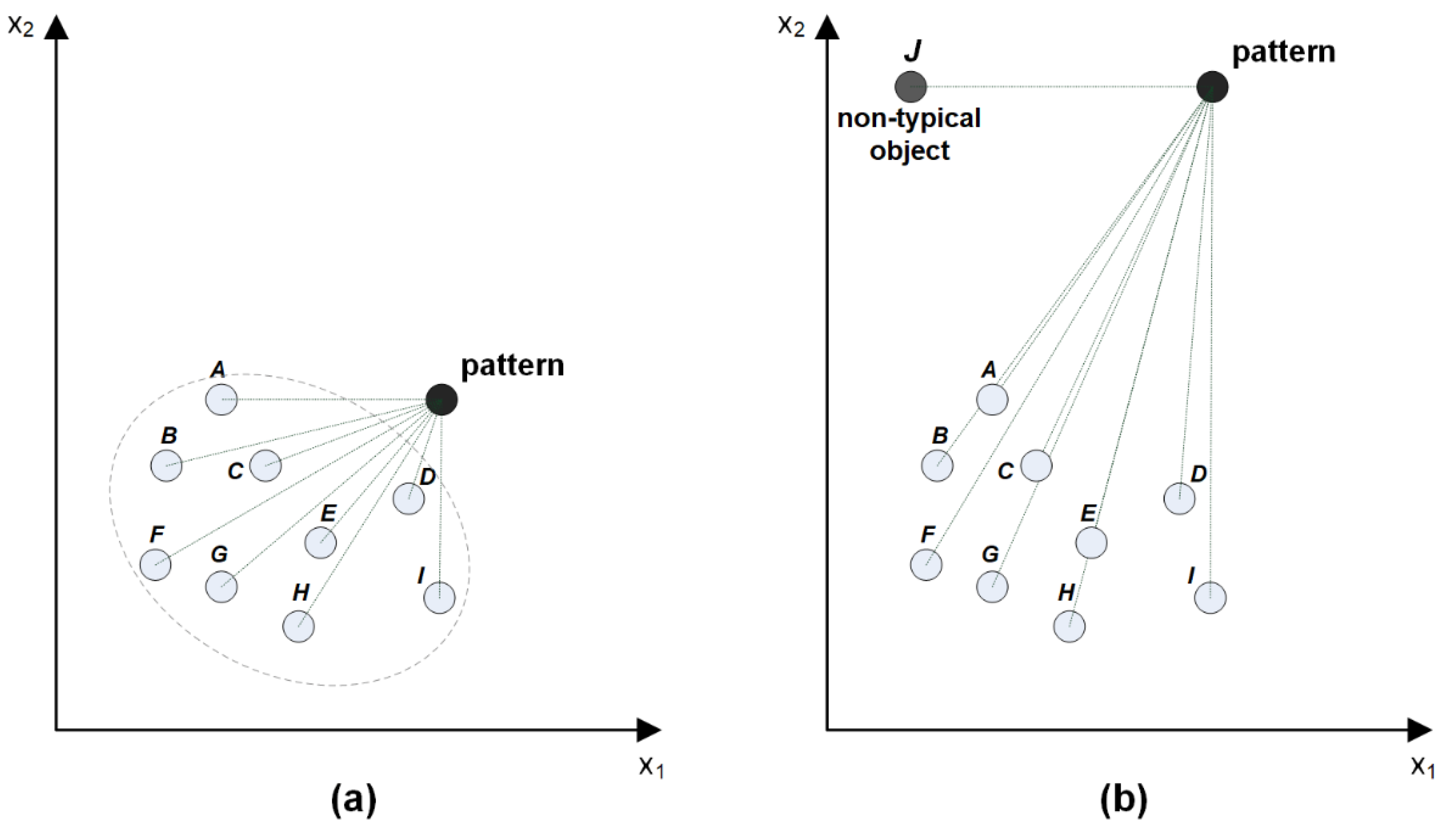

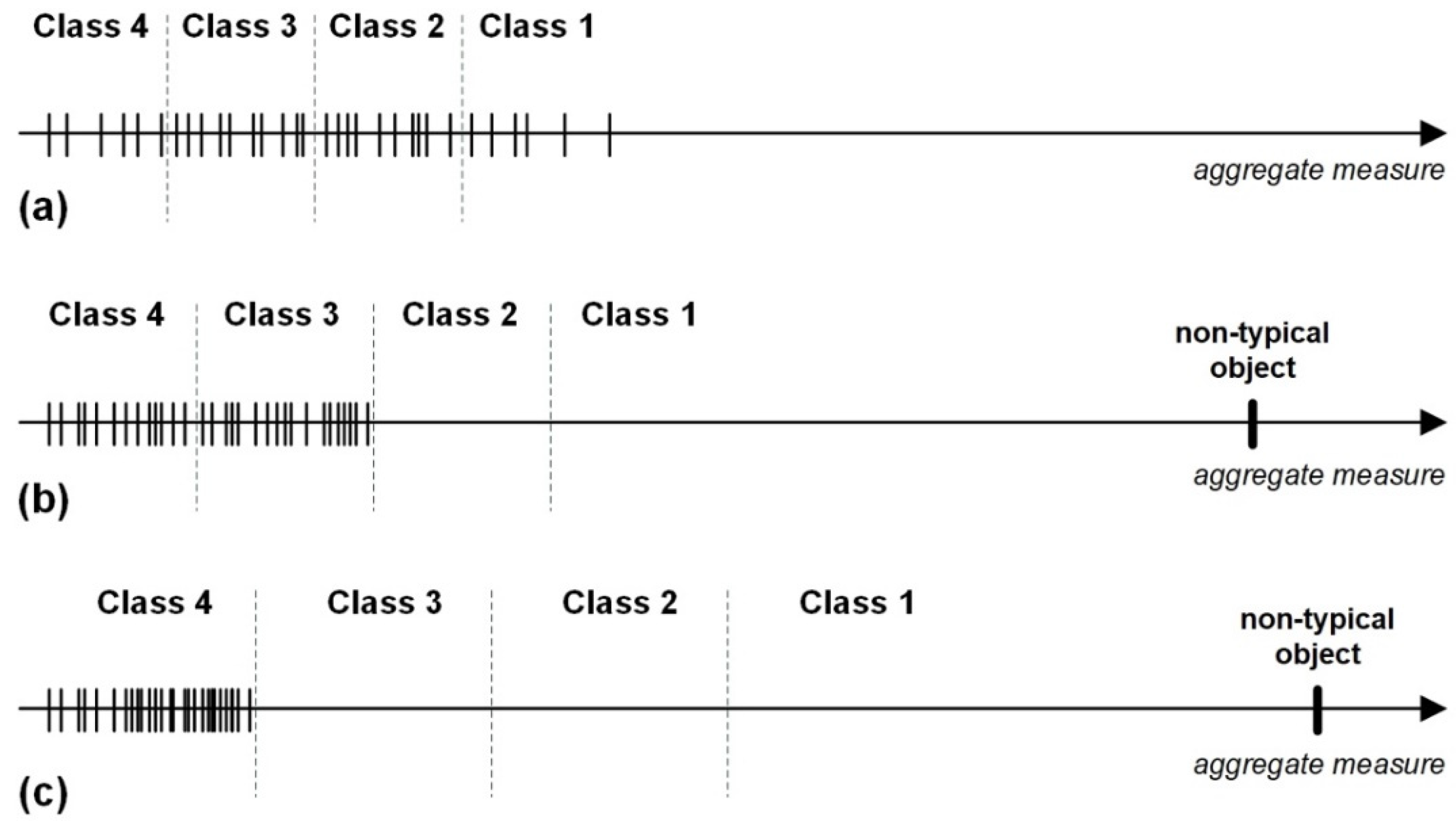

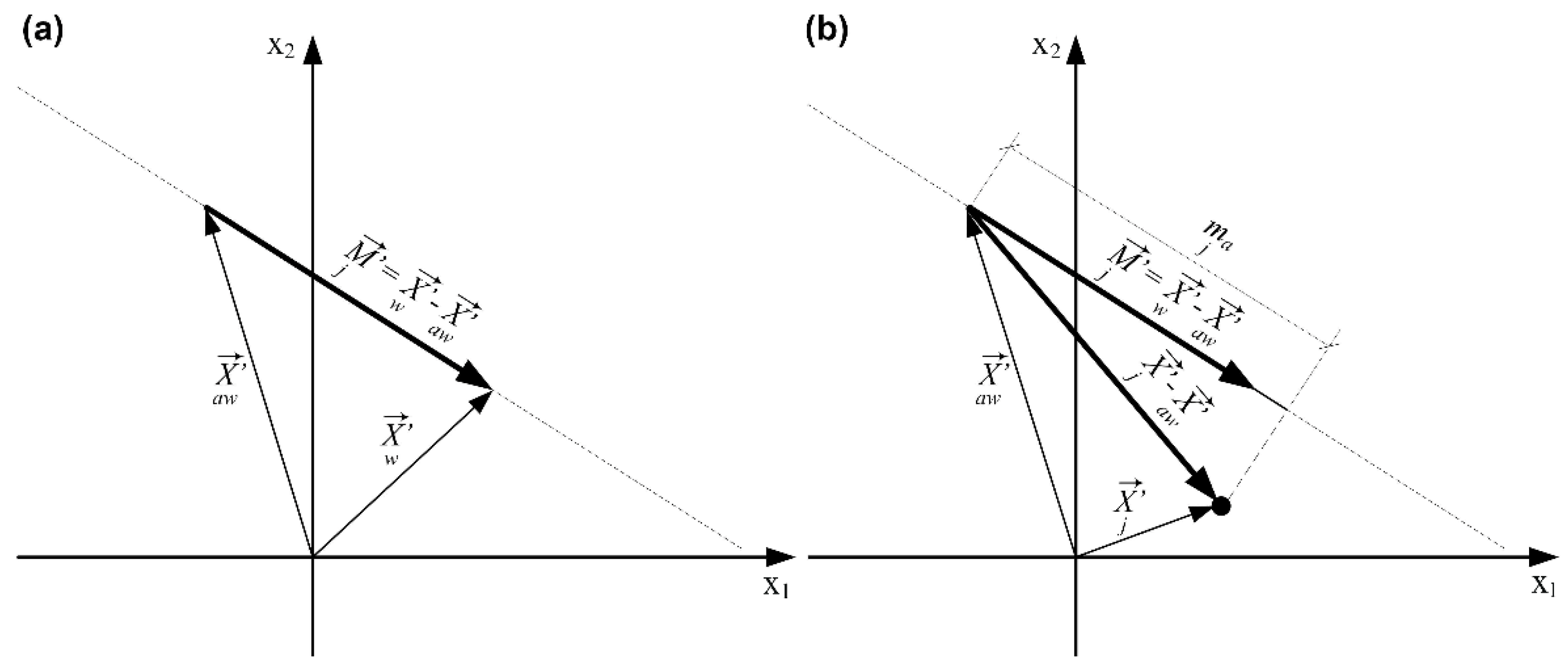
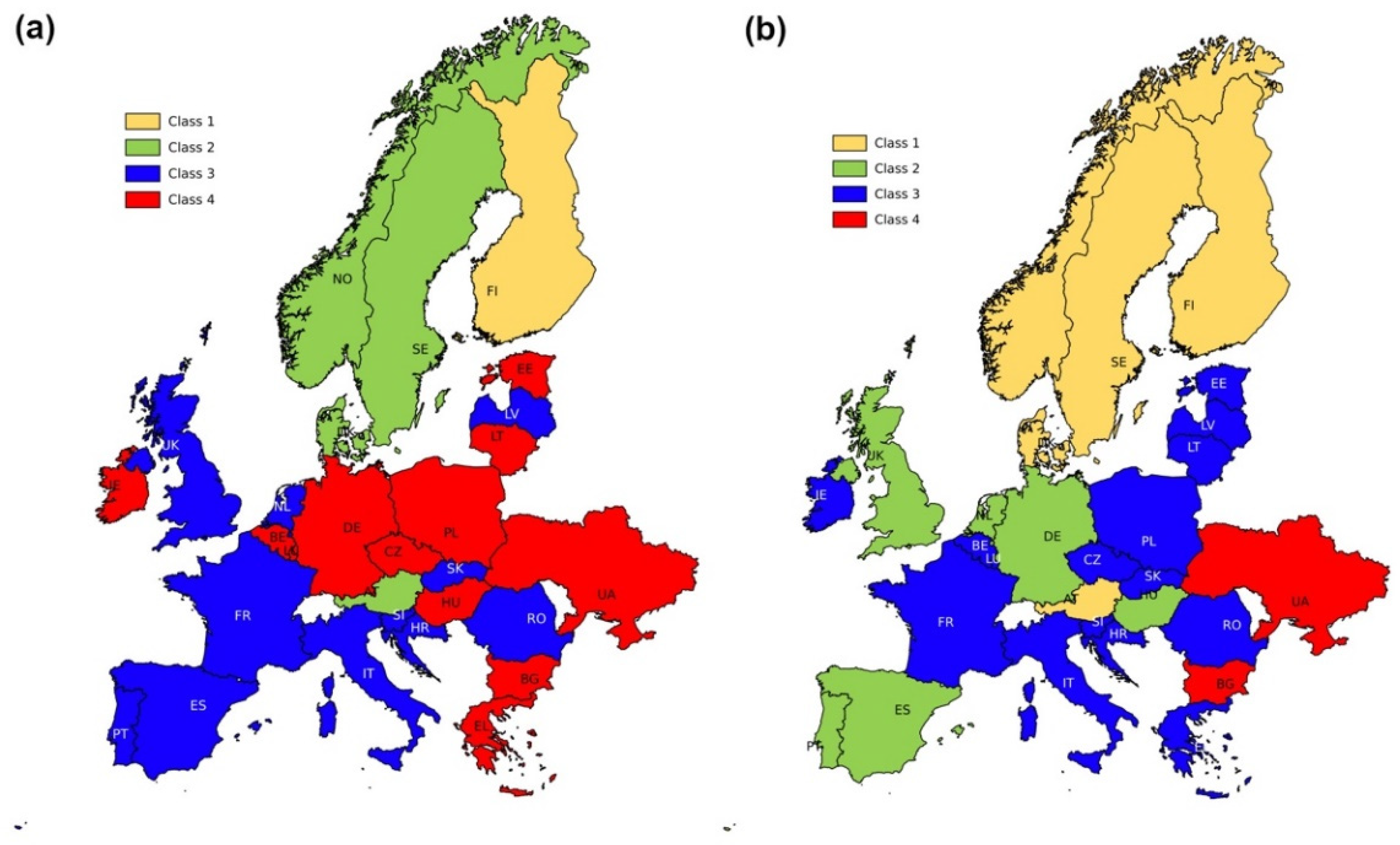
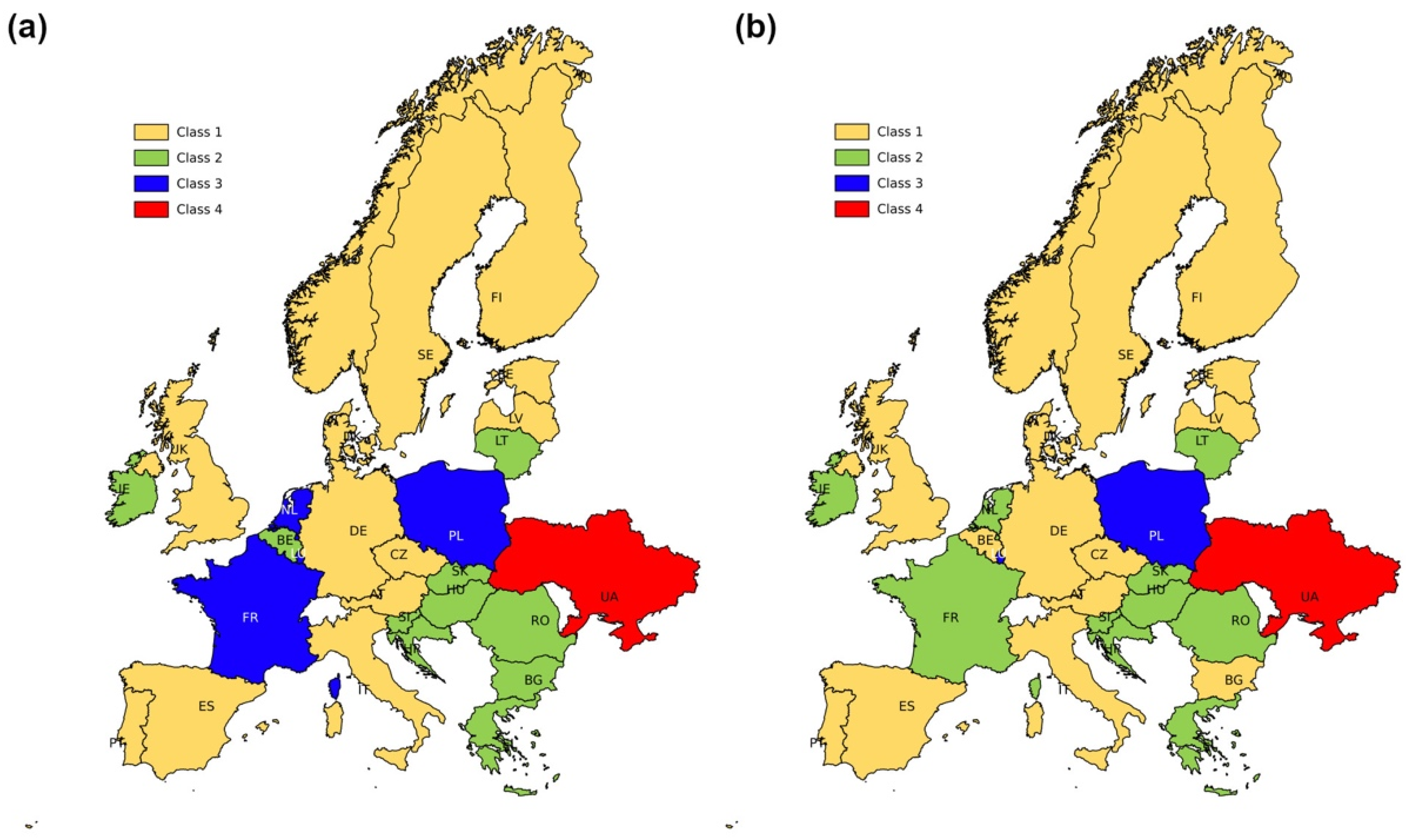
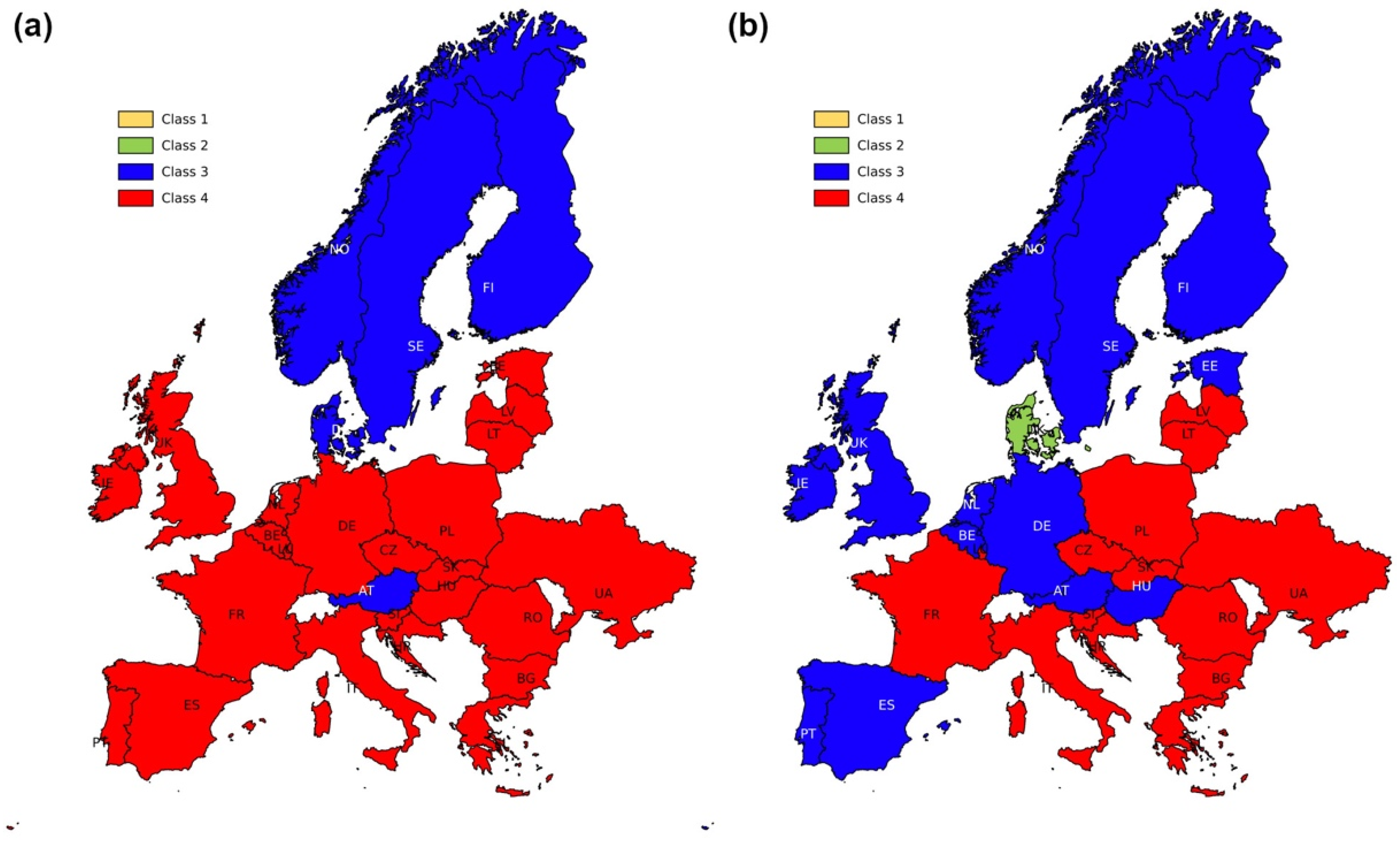
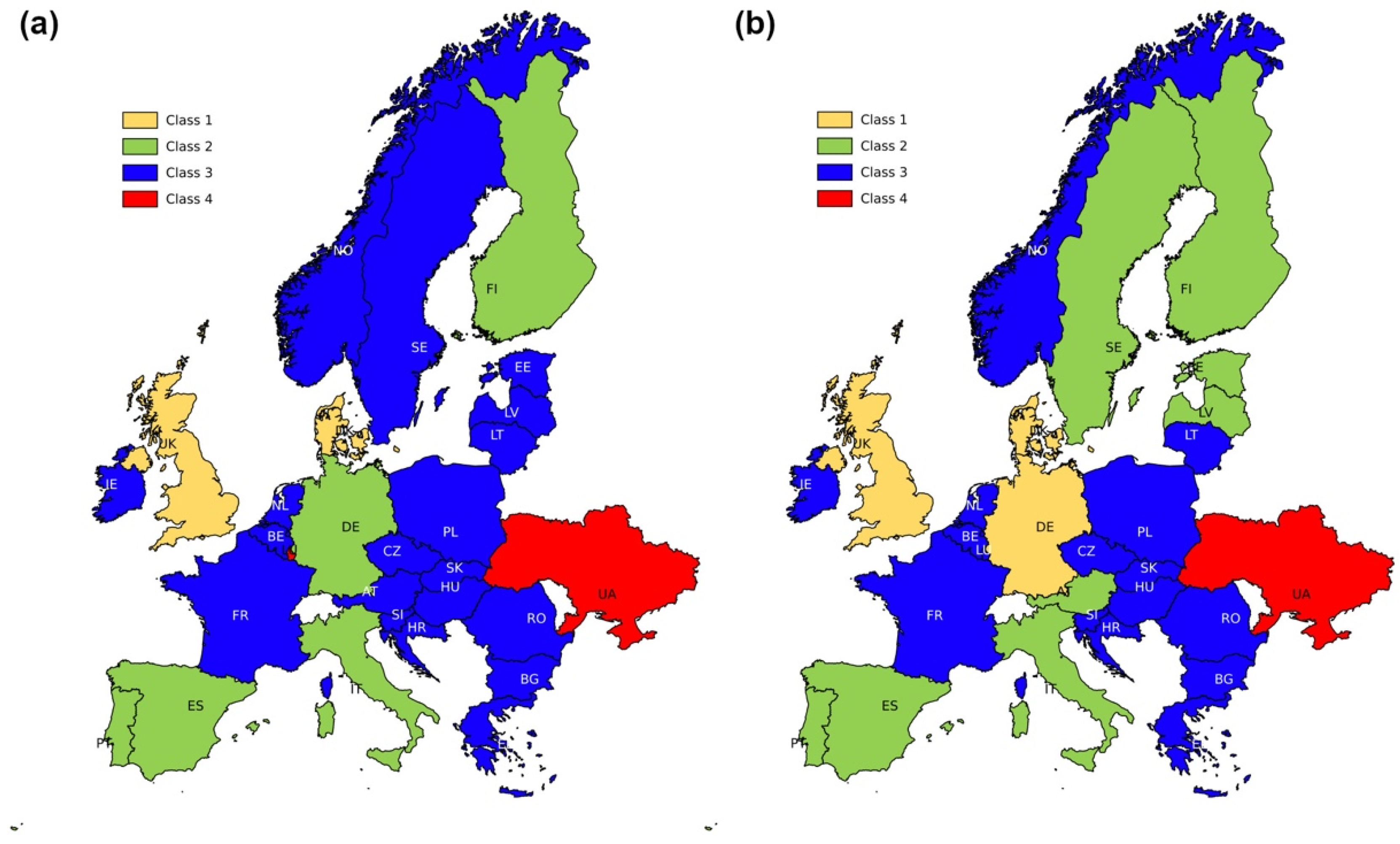
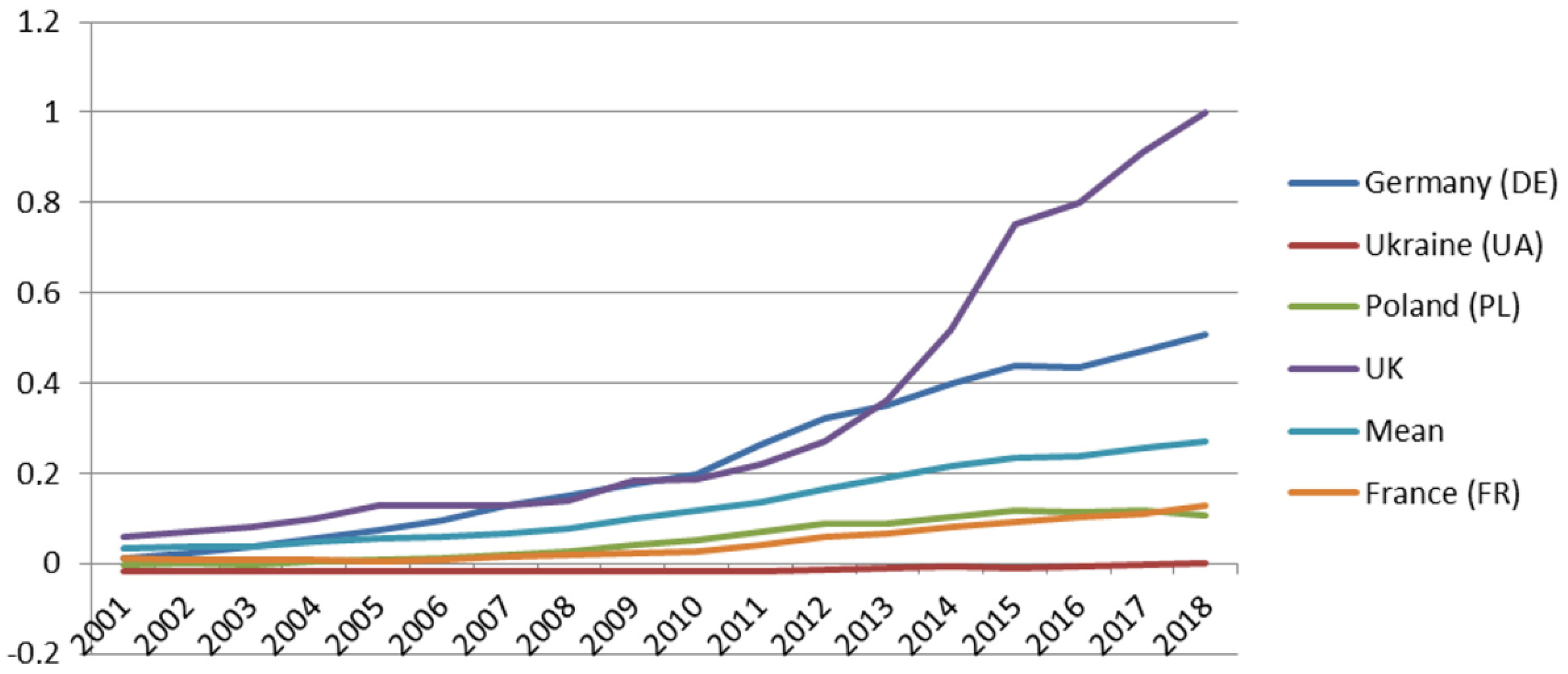
| Objects | Ranking—The First Stage of the Study | Ranking—Value Change by −6 Standard Deviations | ||
|---|---|---|---|---|
| Measure Value | Ranking Position | Measure Value | Ranking Position | |
| United Kingdom (UK) | 0.605 | 1 | 0.643 | 1 |
| Denmark (DK) | 0.454 | 2 | 0.511 | 2 |
| Norway (NO) | 0.441 | 3 | 0.483 | 4 |
| Germany (DE) | 0.412 | 4 | 0.491 | 3 |
| Austria (AT) | 0.365 | 5 | 0.454 | 5 |
| Latvia (LV) | 0.362 | 6 | 0.434 | 6 |
| Sweden (SE) | 0.337 | 7 | 0.421 | 9 |
| Estonia (EE) | 0.322 | 8 | 0.397 | 7 |
| Italy (IT) | 0.306 | 9 | 0.427 | 11 |
| Portugal (PT) | 0.303 | 10 | 0.402 | 10 |
| Europe (E) | 0.279 | 11 | 0.411 | 12 |
| Greece (EL) | 0.275 | 12 | 0.402 | 8 |
| Croatia (HR) | 0.273 | 13 | 0.377 | 15 |
| Ireland (IE) | 0.271 | 14 | 0.357 | 16 |
| Spain (ES) | 0.266 | 15 | 0.396 | 13 |
| Romania (RO) | 0.256 | 16 | 0.384 | 17 |
| Czechia (CZ) | 0.250 | 17 | 0.377 | 19 |
| Belgium (BE) | 0.216 | 18 | 0.368 | 18 |
| Bulgaria (BG) | 0.212 | 19 | 0.370 | 14 |
| Slovenia (SI) | 0.191 | 20 | 0.339 | 20 |
| Slovakia (SK) | 0.175 | 21 | 0.337 | 21 |
| Netherlands (NL) | 0.155 | 22 | 0.332 | 22 |
| Lithuania (LT) | 0.152 | 23 | 0.315 | 24 |
| France (FR) | 0.142 | 24 | 0.325 | 23 |
| Hungary (HU) | 0.130 | 25 | 0.309 | 26 |
| Luxembourg (LU) | 0.128 | 26 | 0.314 | 25 |
| Poland (PL) | 0.109 | 27 | 0.288 | 27 |
| Ukraine (UA) | 0.026 | 28 | 0.269 | 28 |
| Objects | Ranking—The First Stage of the Study | Ranking—Value Change by −6 Standard Deviations | ||
|---|---|---|---|---|
| Measure Value | Ranking Position | Measure Value | Ranking Position | |
| United Kingdom (UK) | 0.916 | 1 | 0.915 | 1 |
| Europe (E) | 0.677 | 2 | 0.683 | 2 |
| Austria (AT) | 0.311 | 3 | 0.311 | 3 |
| Germany (DE) | 0.739 | 4 | 0.727 | 5 |
| Denmark (DK) | 0.626 | 5 | 0.641 | 4 |
| Italy (IT) | 0.798 | 6 | 0.802 | 6 |
| Bulgaria (BG) | 0.414 | 7 | 0.403 | 7 |
| Spain (ES) | 0.897 | 8 | 0.896 | 8 |
| Portugal (PT) | 0.843 | 9 | 0.850 | 9 |
| Croatia (HR) | 0.602 | 10 | 0.614 | 10 |
| Norway (NO) | 0.831 | 11 | 0.817 | 11 |
| Latvia (LV) | 0.801 | 12 | 0.786 | 12 |
| Sweden (SE) | 0.912 | 13 | 0.906 | 13 |
| Czechia (CZ) | 0.617 | 14 | 0.600 | 15 |
| Estonia (EE) | 0.649 | 15 | 0.654 | 14 |
| France (FR) | 0.707 | 16 | 0.698 | 16 |
| Greece (EL) | 0.749 | 17 | 0.729 | 18 |
| Lithuania (LT) | 0.806 | 18 | 0.807 | 19 |
| Ireland (IE) | 0.771 | 19 | 0.753 | 20 |
| Romania (RO) | 0.887 | 20 | 0.886 | 17 |
| Belgium (BE) | 0.381 | 21 | 0.383 | 21 |
| Slovakia (SK) | 0.892 | 22 | 0.892 | 22 |
| Luxembourg (LU) | 0.8190 | 23 | 0.836 | 23 |
| Netherlands (NL) | 0.8191 | 24 | 0.813 | 25 |
| Slovenia (SI) | 0.897 | 25 | 0.902 | 24 |
| Poland (PL) | 0.832 | 26 | 0.833 | 26 |
| Hungary (HU) | 0.764 | 27 | 0.745 | 27 |
| Ukraine (UA) | 1.000 | 28 | 1.000 | 28 |
| Objects | Ranking—The First Stage of the Study | Ranking—Value Change by −6 Standard Deviations | ||
|---|---|---|---|---|
| Measure Value | Ranking Position | Measure Value | Ranking Position | |
| United Kingdom (UK) | 2.497 | 1 | 2.499 | 1 |
| Denmark (DK) | 1.392 | 2 | 1.418 | 2 |
| Germany (DE) | 1.387 | 3 | 1.363 | 3 |
| Norway (NO) | 1.185 | 4 | 1.229 | 4 |
| Austria (AT) | 1.082 | 5 | 1.104 | 5 |
| Latvia (LV) | 0.931 | 6 | 0.967 | 6 |
| Sweden (SE) | 0.883 | 8 | 0.914 | 7 |
| Italy (IT) | 0.927 | 7 | 0.897 | 8 |
| Europe (E) | 0.863 | 9 | 0.856 | 9 |
| Portugal (PT) | 0.802 | 10 | 0.815 | 10 |
| Spain (ES) | 0.712 | 13 | 0.694 | 11 |
| Croatia (HR) | 0.666 | 11 | 0.688 | 12 |
| Greece (EL) | 0.718 | 14 | 0.681 | 13 |
| Romania (RO) | 0.672 | 12 | 0.667 | 14 |
| Estonia (EE) | 0.586 | 15 | 0.605 | 15 |
| Czechia (CZ) | 0.560 | 16 | 0.547 | 16 |
| Bulgaria (BG) | 0.560 | 17 | 0.544 | 17 |
| Belgium (BE) | 0.514 | 18 | 0.494 | 18 |
| Ireland (IE) | 0.422 | 19 | 0.438 | 19 |
| Slovenia (SI) | 0.379 | 20 | 0.377 | 20 |
| Slovakia (SK) | 0.368 | 21 | 0.363 | 21 |
| France (FR) | 0.288 | 22 | 0.279 | 22 |
| Netherlands (NL) | 0.283 | 23 | 0.266 | 23 |
| Lithuania (LT) | 0.254 | 24 | 0.258 | 24 |
| Luxembourg (LU) | 0.203 | 25 | 0.195 | 25 |
| Hungary (HU) | 0.131 | 26 | 0.123 | 26 |
| Poland (PL) | 0.055 | 27 | 0.056 | 27 |
| Ukraine (UA) | −0.184 | 28 | −0.195 | 28 |
| 2001 | 2009 | 2018 | ||||||
|---|---|---|---|---|---|---|---|---|
| Country | Measure Value | Class | Country | Measure Value | Class | Country | Measure Value | Class |
| FI | 1.49 | 1 | AT | 1.70 | 1 | UK | 5.49 | 1 |
| AT | 1.11 | 2 | SE | 1.67 | 1 | DK | 3.59 | 1 |
| NO | 1.08 | 2 | DK | 1.67 | 1 | DE | 2.52 | 1 |
| SE | 0.90 | 2 | FI | 1.55 | 1 | EE | 2.34 | 1 |
| DK | 0.76 | 2 | NO | 1.52 | 1 | FI | 2.30 | 1 |
| LV | 0.56 | 3 | UK | 1.10 | 2 | LV | 2.20 | 1 |
| HR | 0.51 | 3 | DE | 0.98 | 2 | AT | 1.98 | 1 |
| PT | 0.43 | 3 | ES | 0.85 | 2 | SE | 1.96 | 1 |
| UK | 0.38 | 3 | HU | 0.79 | 2 | IT | 1.63 | 1 |
| SI | 0.33 | 3 | PT | 0.76 | 2 | NO | 1.57 | 1 |
| ES | 0.29 | 3 | NL | 0.67 | 2 | PT | 1.53 | 1 |
| RO | 0.26 | 3 | LV | 0.62 | 3 | CZ | 1.37 | 1 |
| SK | 0.18 | 3 | EE | 0.56 | 3 | ES | 1.35 | 1 |
| NL | 0.16 | 3 | SI | 0.55 | 3 | BE | 1.34 | 1 |
| IT | 0.15 | 3 | BE | 0.54 | 3 | BG | 1.24 | 1 |
| FR | 0.14 | 3 | IT | 0.42 | 3 | HR | 1.18 | 2 |
| DE | 0.08 | 4 | HR | 0.41 | 3 | EL | 1.16 | 2 |
| CZ | 0.04 | 4 | CZ | 0.40 | 3 | IE | 1.15 | 2 |
| PL | 0.02 | 4 | IE | 0.38 | 3 | SK | 1.03 | 2 |
| IE | 0.01 | 4 | SK | 0.37 | 3 | RO | 1.03 | 2 |
| EL | −0.01 | 4 | PL | 0.28 | 3 | LT | 0.92 | 2 |
| LU | −0.01 | 4 | RO | 0.27 | 3 | NL | 0.86 | 2 |
| BE | −0.03 | 4 | FR | 0.17 | 3 | HU | 0.81 | 2 |
| BG | −0.05 | 4 | EL | 0.16 | 3 | SI | 0.69 | 2 |
| LT | −0.06 | 4 | LT | 0.15 | 3 | FR | 0.68 | 2 |
| UA | −0.09 | 4 | LU | 0.14 | 3 | LU | 0.66 | 3 |
| EE | −0.10 | 4 | BG | 0.04 | 4 | PL | 0.57 | 3 |
| HU | −0.10 | 4 | UA | −0.08 | 4 | UA | −0.01 | 4 |
| Country | Variables | ||||||||||
|---|---|---|---|---|---|---|---|---|---|---|---|
| X1 | X2 | X3 | X4 | X5 | X6 | X7 | X8 | X9 | X10 | X11 | |
| UK | 0.88 | 0.07 | 0.04 | 0.46 | 0.25 | 0.10 | 0.10 | 0.27 | 0.22 | 0.19 | 0.05 |
| Ukraine | 0.04 | 0.04 | 0.03 | 0.00 | 0.00 | 0.01 | 0.01 | 0.00 | 0.00 | 0.00 | 0.00 |
| Difference | 0.84 | 0.03 | 0.01 | 0.46 | 0.24 | 0.10 | 0.10 | 0.27 | 0.22 | 0.19 | 0.05 |
| 2001 | 2009 | 2018 | ||||||
|---|---|---|---|---|---|---|---|---|
| Country | Measure Value | Class | Country | Measure Value | Class | Country | Measure Value | Class |
| FI | 0.21 | 3 | DK | 0.29 | 2 | UK | 1.00 | 1 |
| DK | 0.14 | 3 | AT | 0.22 | 3 | DK | 0.65 | 1 |
| AT | 0.13 | 3 | SE | 0.22 | 3 | DE | 0.51 | 1 |
| NO | 0.11 | 3 | FI | 0.22 | 3 | EE | 0.36 | 2 |
| SE | 0.10 | 3 | UK | 0.18 | 3 | FI | 0.35 | 2 |
| UK | 0.06 | 4 | DE | 0.18 | 3 | LV | 0.32 | 2 |
| LV | 0.05 | 4 | ES | 0.18 | 3 | IT | 0.32 | 2 |
| PT | 0.05 | 4 | NO | 0.17 | 3 | AT | 0.30 | 2 |
| HR | 0.05 | 4 | PT | 0.14 | 3 | SE | 0.30 | 2 |
| ES | 0.04 | 4 | HU | 0.12 | 3 | PT | 0.29 | 2 |
| SI | 0.03 | 4 | NL | 0.11 | 3 | ES | 0.28 | 2 |
| NL | 0.02 | 4 | EE | 0.09 | 3 | EL | 0.26 | 3 |
| RO | 0.02 | 4 | BE | 0.08 | 3 | BE | 0.26 | 3 |
| SK | 0.01 | 4 | IE | 0.08 | 3 | CZ | 0.25 | 3 |
| IT | 0.01 | 4 | LV | 0.07 | 4 | IE | 0.24 | 3 |
| DE | 0.01 | 4 | SI | 0.06 | 4 | BG | 0.22 | 3 |
| FR | 0.01 | 4 | IT | 0.06 | 4 | RO | 0.20 | 3 |
| CZ | 0.00 | 4 | CZ | 0.06 | 4 | NO | 0.18 | 3 |
| IE | 0.00 | 4 | SK | 0.04 | 4 | HR | 0.18 | 3 |
| PL | 0.00 | 4 | PL | 0.04 | 4 | NL | 0.17 | 3 |
| EL | 0.00 | 4 | HR | 0.04 | 4 | SK | 0.17 | 3 |
| BE | −0.01 | 4 | EL | 0.03 | 4 | LT | 0.16 | 3 |
| LU | −0.01 | 4 | FR | 0.02 | 4 | HU | 0.14 | 3 |
| BG | −0.01 | 4 | RO | 0.02 | 4 | FR | 0.13 | 3 |
| LT | −0.02 | 4 | LU | 0.02 | 4 | LU | 0.11 | 3 |
| UA | −0.02 | 4 | LT | 0.02 | 4 | PL | 0.11 | 3 |
| EE | −0.02 | 4 | BG | 0.00 | 4 | SI | 0.10 | 3 |
| HU | −0.02 | 4 | UA | −0.02 | 4 | UA | 0.00 | 4 |
Publisher’s Note: MDPI stays neutral with regard to jurisdictional claims in published maps and institutional affiliations. |
© 2021 by the authors. Licensee MDPI, Basel, Switzerland. This article is an open access article distributed under the terms and conditions of the Creative Commons Attribution (CC BY) license (https://creativecommons.org/licenses/by/4.0/).
Share and Cite
Piwowarski, M.; Borawski, M.; Nermend, K. The Problem of Non-Typical Objects in the Multidimensional Comparative Analysis of the Level of Renewable Energy Development. Energies 2021, 14, 5803. https://doi.org/10.3390/en14185803
Piwowarski M, Borawski M, Nermend K. The Problem of Non-Typical Objects in the Multidimensional Comparative Analysis of the Level of Renewable Energy Development. Energies. 2021; 14(18):5803. https://doi.org/10.3390/en14185803
Chicago/Turabian StylePiwowarski, Mateusz, Mariusz Borawski, and Kesra Nermend. 2021. "The Problem of Non-Typical Objects in the Multidimensional Comparative Analysis of the Level of Renewable Energy Development" Energies 14, no. 18: 5803. https://doi.org/10.3390/en14185803






